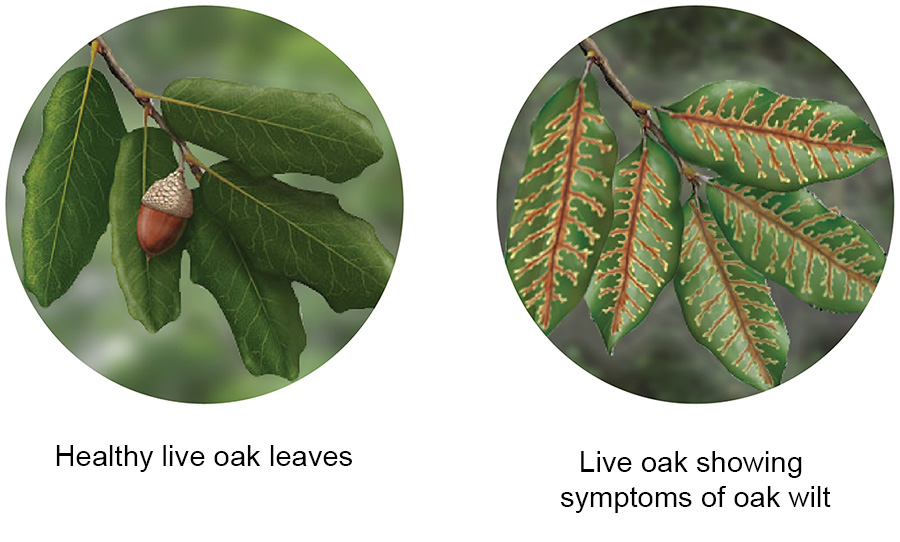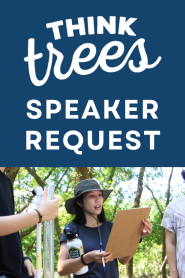What is Oak Wilt?
Oak wilt is a fungal tree disease that spreads rapidly and can kill oak trees.
The City provides resources and support your neighborhood can use to monitor oak wilt infections in your area, and to develop projects that increase the resilience of your tree canopy.
Learn the Signs of Oak Wilt

Are My Trees at Risk?
Any oak tree can get infected with oak wilt, and it can be difficult to prevent even when you take good care of your trees. In Austin, live oak is the most frequently infected tree.
Will My Trees Die?
When neighbors know about oak wilt and work together, they can save trees. While the oak wilt fungus will still spread through root systems even when trees are treated, a carefully timed fungicide injection can save oak trees.
Do I Have Oak Trees?
The following resources can help you identify what type of tree you have.
- Texas A&M Forest Service Tree Planting Guide – Oak Trees
- Expert Advice from Travis County Master Gardeners
- Texas A&M Forest Service's Trees of Texas
- iNaturalist Community and Mobile Apps
How Can We Control Oak Wilt?
Connect with Neighbors
Since oak wilt does not stop at property lines and still spreads through the root systems of treated trees, it is best controlled when neighbors work together and share information about the location of infected trees and their treatment history. If you would like a presentation about oak wilt at neighborhood meeting that can help facilitate this conversation, please email a request to Keith Babberney.
Conduct a Neighborhood Forest Health Assessment (NFHA)
Organize as a neighborhood to hire an arborist to conduct a Neighborhood Forest Health Assessment (NFHA). The NFHA can spotlight the conditions of the tree canopy, identify opportunities to increase tree and forest resilience, increase tree stewardship among the community, and leverage partnerships and community resources to strengthen the urban forest canopy in Austin. The arborist selected can perform field observations from the street and sidewalk, collect data, and share findings with the neighborhood.
Access the Neighborhood Forest Health Assessment Guidelines to support your neighborhood’s efforts. A NFHA is an eligible project for neighborhoods seeking to apply for financial assistance through the Urban Forest Grant program.
The NFHA program is facilitated by the City of Austin’s (COA) Urban Forest Health Coordinator. Complete NFHAs shared with the COA contribute to the monitoring of Austin’s urban forest. If you have questions about this program, please contact the Urban Forest Health Coordinator.
Paint When You Prune
Most trees need pruning to achieve good form, but each cut is an opportunity for insects and diseases to enter the tree. So, consider every cut carefully. Although you can prune at any time of year, the best time to prune oaks is July through January. That’s when fungal spores are least likely to infect a tree. Always paint pruning cuts and wounds on oak trees. Any type of paint can mask the smell of a fresh wound from the beetle that can carry oak wilt spores.
Contact a Qualified Arborist
A Qualified Arborist can diagnose tree problems and provide treatment recommendations.
- Oak Wilt Qualified Arborists
- American Society of Consulting Arborists
- International Society of Arboriculture
Is Oak Wilt in Your Neighborhood?
This map shows potential oak wilt infection areas within Austin's jurisdiction based on symptoms observed within the last 10 years. While we strive to keep the data current, the map may not always reflect the latest conditions.
Although all areas have some level of potential risk, red areas indicate the highest risk of infection while green areas are at lower risk (map deliberately obscures exact locations of known infections due to privacy concerns). Additional infection areas may exist in Austin and surrounding cities. Contact a Texas Oak Wilt Qualified Arborist to assess your risk and identify suppression strategies.
See the City of Austin's GIS disclaimer for information regarding the accuracy and appropriate uses of this data.
Additional Resources
Oak Wilt 101 – Nature in the City Blog
The Role of Red Oaks in the Oak Wilt Cycle – Nature in the City Blog
Learn more about oak wilt at TexasOakWilt.org


